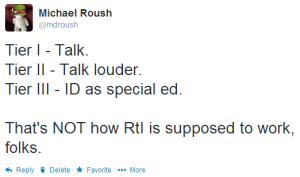A recent tweet of mine got several favorites/retweets. It was, like many of my tweets, a sudden off-the-cuff remark sparked by something I heard.
 “Tier I – Talk. Tier II – Talk louder. Tier III – ID as special ed. That’s NOT how RtI is supposed to work, folks.”
“Tier I – Talk. Tier II – Talk louder. Tier III – ID as special ed. That’s NOT how RtI is supposed to work, folks.”
My suggestions for implementing Response to Intervention in a way that will actually benefit kids:
- Don’t use RtI as an excuse to homogenize Tier I. Tier II is not an excuse not to implement universal design in Tier I. The more kids you let fall into Tier II, the more difficult you are making it.
- Tier II is not “Tier I again, a little slower and a little louder.” If Tier I instruction wasn’t sufficient, there should be formative assessment data that shows where the deficiency exists, so that a targeted intervention can be implemented. Not all kids “didn’t get it” for the same reason, and the same intervention won’t work for all.
- Tier III is not the “gateway to special ed”. Just because a student is identified as being in need of Tier III instruction in an RtI model does not mean they have some disability. It means the attempts at instruction so far have been unsuccessful, and a larger barrier exists that must be addressed.
- Tier III does not allow you to delay special education referral and identification. “States and LEAs [Local Educational Agencies] have an obligation to ensure that evaluations of children suspected of having a disability are not delayed or denied because of implementation of an RtI strategy.” (OSEP Memo, 1-21-2011.) In other words, “Well, we think Johnny might have a disability, but we’re doing RtI with him. If Johnny gets to Tier III, then we’ll set up an evaluation.” is a violation of Johnny’s civil rights.
- Response to Intervention isn’t something you only do with your special education or “at-risk” population.
- Tier III shouldn’t be a final and unchangeable designation for any student. If a certain student is always in Tier III, there’s a problem somewhere in Tier I and Tier II.
In short, Response to Intervention is not a sorting mechanism, or a panacea for student achievement gaps. It only works when a teacher uses it as feedback for how well their instruction is doing its job, and changes how they teach based on what helps their students learn best.